 Image search results - "enter" Image search results - "enter" |

Entrance road to JRA (Japan Racing Association) Ritto Training Center. MAP
|
|

Toki Messe's tower is the city's tallest building at 140 meters.
|
|

Kachidoki (Victory) Bridge with race horse motif.
|
|

Toki Messe is a multipurpose complex which includes a convention center, exhibition hall, hotel and office tower (the city's tallest building), art museum, and an observation deck on the 31st floor.
|
|

Bridge sidewalk.
|
|

The observation deck is about 125 meters above the ground. The tallest building along the Sea of Japan coast. Fine view of Shinano River.
|
|

Kachidoki Bridge
|
|

In the foreground is Bandaibashi Bridge, spanning Shinano River.
|
|

Map of Ritto Training Center. Horse stables dominate the area.
|
|
|

Welcome to the JRA office, where the free 90 min. (1 pm - 2:30 pm) tour starts. (Reservations by phone required.)
|
|
|

24-hour strict security in place. Since 1969, the government-run Japan Racing Association (JRA) has trained jockeys and race horses in Ritto. It offers free tours of this large, impressive facility on Sunday afternoons and early Wednesday mornings.
|
|

Too hazy to see Sado island.
|
|

Starting gate training ground.
|
|

Toward the mouth of Shinano River.
|
|

Starting gates. The left gate has the largest width for beginner horses until they can get used to the narrow gates on the right. Some horses refuse to leave the gate.
|
|
|

What the horse sees inside the narrow starting gate.
|
|

Ferry to Sado island.
|
|

Practice track
|
|
|

Hypocenter of atomic bomb, adjacent to Peace parkAlmost right next to the Peace park is the hypocenter marker above which the bomb exploded. Often hoards of students on class trips can be see squatting here listening to a talk about this place.
|
|

Practice horse track at JRA Ritto Training Center in Ritto.
|
|
|
|
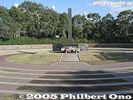
Hypocenter of atomic bombA series of concentric circles emanate from the marker.
|
|
|

Fishing boats
|
|

Hypocenter markerOn August 9, 1945 an atomic bomb exploded in the sky about 500 meters above the point where this monument now stands. The area within a 2.5 kilometer radius of the hypocenter was completely devastated.
|
|

The training track consists of several different tracks with grass, dirt, or wood chips.
|
|
|

Hypocenter description
|
|

Horse stable model
|
|
|

Remains of Urakami Cathedral wallNext to the hypocenter is this partial cathedral wall.
|
|

Horse feed, mainly grain. No meats.
|
|

Central Niigata
|
|

Hypocenter
|
|

Swimming pool for horses. There is a circular pool and straight and narrow pools.
|
|

Memorial at hypocenterErected in July 1995 for the 50th anniversary.
|
|

Horse stables, newly constructed.
|
|

Horse stables.
|
|
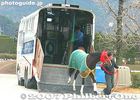
Unloaded a horse after a race. Horse trucks often arrived. One truck usually holds up to four horses.
|
|

Uphill training course with wood chips. 坂路調教馬場
|
|

Uphill training course with observation building. The wood chips are soft, making the horse less prone to injury.
|
|

Inside the observation building's press room.
|
|
|

Nice view of uphill training course. The wood chips, which eventually wear out, are replaced once a year.
|
|

View of track from press room.
|
|

Starting gate on training track.
|
|
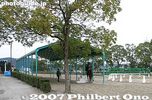
The tour includes a ride on a retired race horse.
|
|
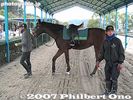
This one is named Meisho Ittetsu. メイショウ イッテツ
|
|
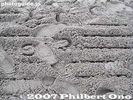
Hoof marks on sand.
|
|
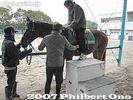
Horse ride.
|
|
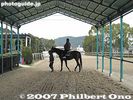
Horse ride with a guide guiding the horse.
|
|

No need to say giddy-up.
|
|
|
|
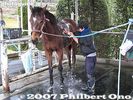
Washing a horse with warrm water.
|
|
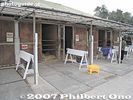
Horse stables.
|
|
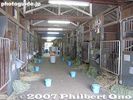
Horse stables.
|
|
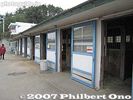
Horse stables.
|
|
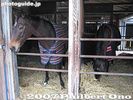
Horses in stable.
|
|

Unusual horse with a white face.
|
|
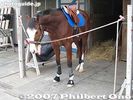
The left profile is brown.
|
|

Hi horsey!
|
|
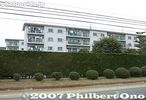
Staff living quarters
|
|

Free gift given at the end of the tour: Pen, stapler, and ruler set. Very interesting tour even though you don't see any horses running on the track. (That's Wednesday's early morning tour.)
|
|
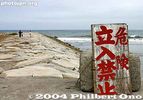
Danger, Keep Out危険 立入禁止 - The kanji characters on the right say "kiken" meaning danger. The big characters on the left say "tachi-iri kinshi" meaning "entry prohibited." Remember the word "kiken" (危険). It is one of the three most common words on warning signs in Japan. Another one is "kinshi" (禁止). If you see it, be aware that something is prohibited.
Place: Ohara beach, Chiba.
|
|
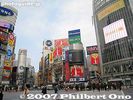
To Dogenzaka and Center-gai arcade
|
|
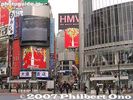
Center-gai arcade
|
|
|
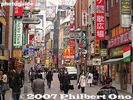
Center-gai arcade
|
|
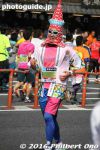
Tokyo Tower
|
|
|
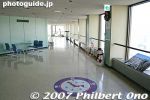
Lookout deck on the World Trade Center in Hamamatsucho.
|
|
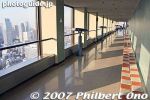
Great views of Tokyo from the World Trade Center Building (世界貿易センタービル) in Hamamatsuchō, Tokyo.
|
|
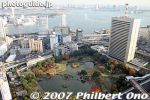
Bird's eye view of Kyu-Shiba Rikyu Gardens as seen from Hamamatsu World Trade Center.
|
|
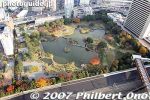
Bird's eye view of Kyu-Shiba Rikyu Gardens as seen from Hamamatsu World Trade Center
|
|

Looking north toward Shimbashi.
|
|
|
|
|
|
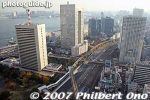
Looking south toward Shinagawa.
|
|
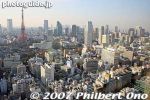
Tokyo Tower as seen from Hamamatsucho.
|
|
|
|
|
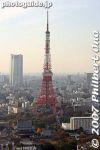
Tokyo Tower
|
|
|
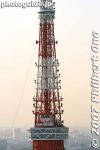
Tokyo Tower as seen from WTC Hamamatsucho.
|
|
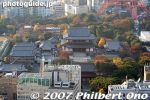
Zojoji temple
|
|
|
|
|
|
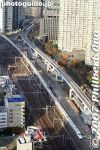
Shinkansen snakes its way through.
|
|
|
|
|
|
|
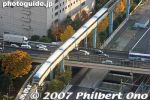
Monorail to Haneda
|
|
|
|
|
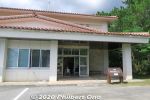
Iriomote Wildlife Conservation Center is a great place to learn about the island's wildlife. There are some English captions too.
|
|
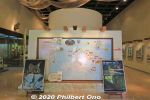
Inside Iriomote Wildlife Conservation Center. One floor full of panel exhibits and stuffed specimens.
|
|

About the Iriomote Wildlife Conservation Center.
|
|

Iriomote map shows where the Iriomote wildcat was sighted (orange tags with date and time) and roadkill locations (red tags). People need to drive carefully.If you see an injured or dead Iriomote wildcat, call 0980-85-5581.
|
|

About Iriomote's wildlife.
|
|
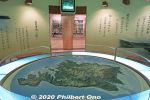
Map of Iriomote.
|
|

Iriomote with the main town of Ohara on the lower right.
|
|
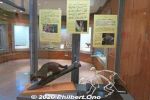
The center's main exhibit is the stuffed Iriomote wildcats.
|
|
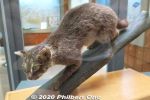
Iriomote is famous for the Iriomote wildcat (イリオモテ ヤマネコ). Endemic to Iriomote and critically endangered.
|
|
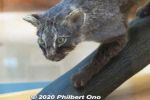
Only 100 or so left on the island. They are nocturnal and have stubby legs and a thick tail. Discovered relatively recently in 1965.
|
|
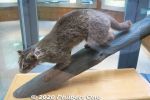
There's no zoo, etc., where we can see a live Iriomote cat. They only have stuffed Iriomote cats here at the Iriomote Wildlife Conservation Center.
|
|
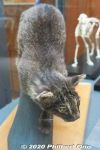
In the past, they did have a live Iriomote cat here, found injured on the road and treated here.
|
|

Characteristics of the Iriomote wildcat.
|
|
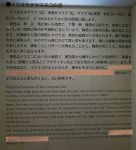
Characteristics of the Iriomote wildcat.
|
|

Even though the Iriomote cat is all over Iriomote as a tourist symbol, we can't see any live ones.
|
|
|
|

Life cycle of Iriomote wildcat.
|
|
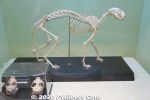
Skeleton of Iriomote wildcat.
|
|
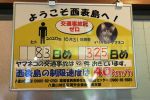
Roadkill of Iriomote cats is a problem especially since they are nocturnal and Iriomote roads are dark. Residents are told to drive slowly at night.
|
|
|
|
|
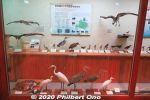
Iriomote's birds.
|
|
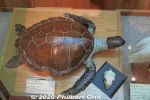
Turtle on Iriomote.
|
|
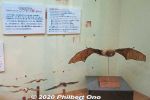
Bats on Iriomote.
|
|

Bats on Iriomote.
|
|
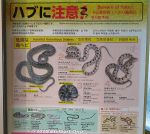
About habu snakes (venomous).
|
|
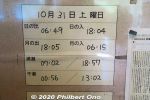
Times for sunrise, sunset, moon rise/set, and high/low tide on Iriomote in Oct.
|
|
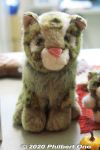
Stuffed toy Iriomote wildcat.
|
|
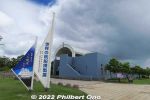
Also in Kaiwo Maru Park is the Japan Sea Culture Center (日本海交流センター) has an exhibition space showing models of sailing ships from around the world. (世界の帆船模型展)
|
|
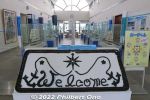
Inside Japan Sea Culture Center (日本海交流センター) showing models of sailing ships from around the world.
|
|

Scale model of the new Kaiwo Maru.
|
|
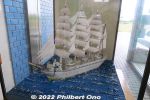
Scale model of Kaiwo Maru.
|
|

Types of sailing ships.
|
|

In Oct. 2014, Toyama Bay was designated as one of the most beautiful bays in the world.
|
|

Types of ships.
|
|

History of Toyama Shinko Port.
|
|

Construction of Shin-Minato Ohashi Bridge at Toyama Shinko Port.
|
|
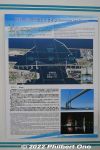
Design of Shin-Minato Ohashi Bridge.
|
|
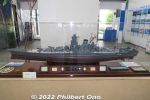
Battleship Yamato too.
|
|
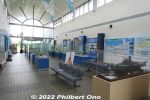
Japan Sea Culture Center (日本海交流センター) exhibition space. It's also a community center with meeting rooms, etc.
|
|
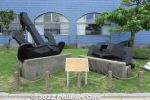
Outside the Japan Sea Culture Center, anchors are displayed.
|
|
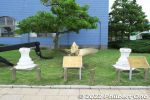
Kaiwo Maru's spare propeller and capstan.
|
|

Kobe Center for Overseas Migration and Cultural Interaction was originally the National Emigration Center (国立移民収容所) where Japanese immigrants stayed for orientation before traveling mainly to South America (especially Brazil) by boat.The Emigration Center was used from 1928 to 1971 and it's Japan's only surviving building used for sending Japanese immigrants. Later renamed Kobe Emigrant Education Center and then Kobe Emigrant Assistance Center and Kobe Emigration Center (神戸移住センター).
|
|

This was where the Japanese immigrants would stay for up to 10 days to prepare for their long boat journey and move to South America.Today, the center is partially a museum where a few of the old rooms used by the emigrants have been restored. Other rooms are rented, including an event hall, meeting rooms, and gallery spaces. It includes a consultation center for South American residents of Kobe.
Museu da Emigração e Centro de Intercâmbio Cultural de Kobe
|
|

During World War II, the facility was used by the Japanese military. Then it became a school for hospital nurses. Today, the building is a South America emigration museum and the base for the Kansai Brazilian Community.There are exhibition rooms showing Kobe's history of Japanese immigration, especially to South America. Art studios, art gallery spaces, and meeting rooms are also provided for cultural exchange.
|
|

It is also has a consultation center for South American residents of Kobe. Operated by the city of Kobe, the current facility opened on June 3, 2009.15-min. walk from JR Motomachi Station (East Exit) on the JR Tokaido/Kobe Line. Walk straight along Koikawa-suji road (鯉川筋). Or 10-min. walk from Kencho-mae Station on the subway line. From JR Shin-Kobe Station (shinkansen), 10-min. taxi ride.
|
|

Monument for the "Birthplace of Japan's Emigration to Brazil" (ブラジル移民発祥の地)
|
|

Entrance.Open 10:00 am -5:00 pm (enter by 4:30 pm), closed Mon. (open if a national holiday and closed on Tue. instead) and December 29 to January 3. Admission: Free
|
|

Portuguese notices.
|
|

The 1st and 2nd floors have the emigration exhibition rooms. The 3rd floor is mainly offices of local Brazilian groups, and the 4th floor has rented studios for artists.
|
|
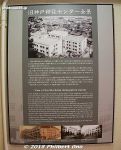
Old Kobe Immigration Center.
|
|

Map of Kobe Port on the floor.
|
|

Room showing farm tools.
|
|

Farm tools
|
|

Emigrant ship to South America.
|
|

Travel routes from Japan to South America.
|
|

It took over 50 days to travel from Japan to South America.
|
|

History of the emigrant center.
|
|
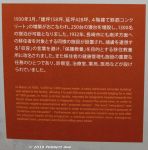
History of the emigrant center: 1930s
|
|
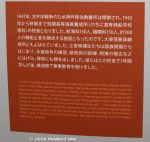
History of the emigrant center: 1940s
|
|

History of the emigrant center: 1950s-60s
|
|
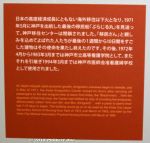
History of the emigrant center: 1970s-80s as a School of Nursing.
|
|
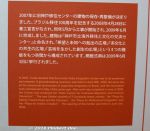
History of the emigrant center: 2007-2009
|
|

Statue of emigrants to Brazil. This same statue also stands at Meriken Park in Kobe.
|
|

Pictures of emigrants.
|
|

Exhibition room
|
|
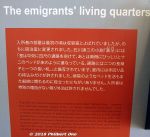
Emigrant's living quarters.
|
|
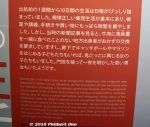
Life in the emigration center.
|
|

Lodging facility reconstructed here.
|
|

This is how the sleeping quarters looked like at the Kobe emigration center.
|
|

This is how the sleeping quarters looked like at the Kobe emigration center.
|
|

This is how the sleeping quarters looked like at the Kobe emigration center.
|
|

Japanese language textbooks.
|
|

Sports equipment.
|
|
|

Emigrants' luggage.
|
|

Electronical appliances.
|
|

Vintage camera
|
|

Corridor on an upper floor.
|
|

Artist studio
|
|

3rd floor
|
|

Exhibition room showing emigration photos.
|
|

Nice stairs
|
|

Toyako Visitor Center
|
|

Volcanic rock which you can touch. Toyako Visitor Center
|
|

How Lake Toya was formed.
|
|

Fishes in Lake Toya
|
|

Birds around Toyako
|
|
|

Toyako Culture Center with G8 Summit flags
|
|

Official logo of the G8 Hokkaido Toyako Summit on the Toyako Culture Center.
|
|

Toyako Visitors Center and Volcano Science Museum in Toyako Onsen Spa.
|
|

G8 Hokkaido Toyako Summit countdown at Toyako Visitors Center and Volcano Science Museum in Toyako Onsen Spa.
|
|
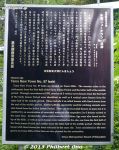
The Tokyo Metropolitan Archaeological Center has a small museum with archaeological artifacts and the neighboring Jomon Village Historic Garden found on the Tama Newtown No. 57 ruins. Highly recommended if you like Jomon Period history.This sign explains about the ruins of a Jomon Period community found here.
|
|

Shopping center where most people shop in central Yokosuka. Despite this megamall, the other shopping areas in town are still thriving. Yokosuka has a vigorous atmosphere. Not economically depressed.
|
|
|
|